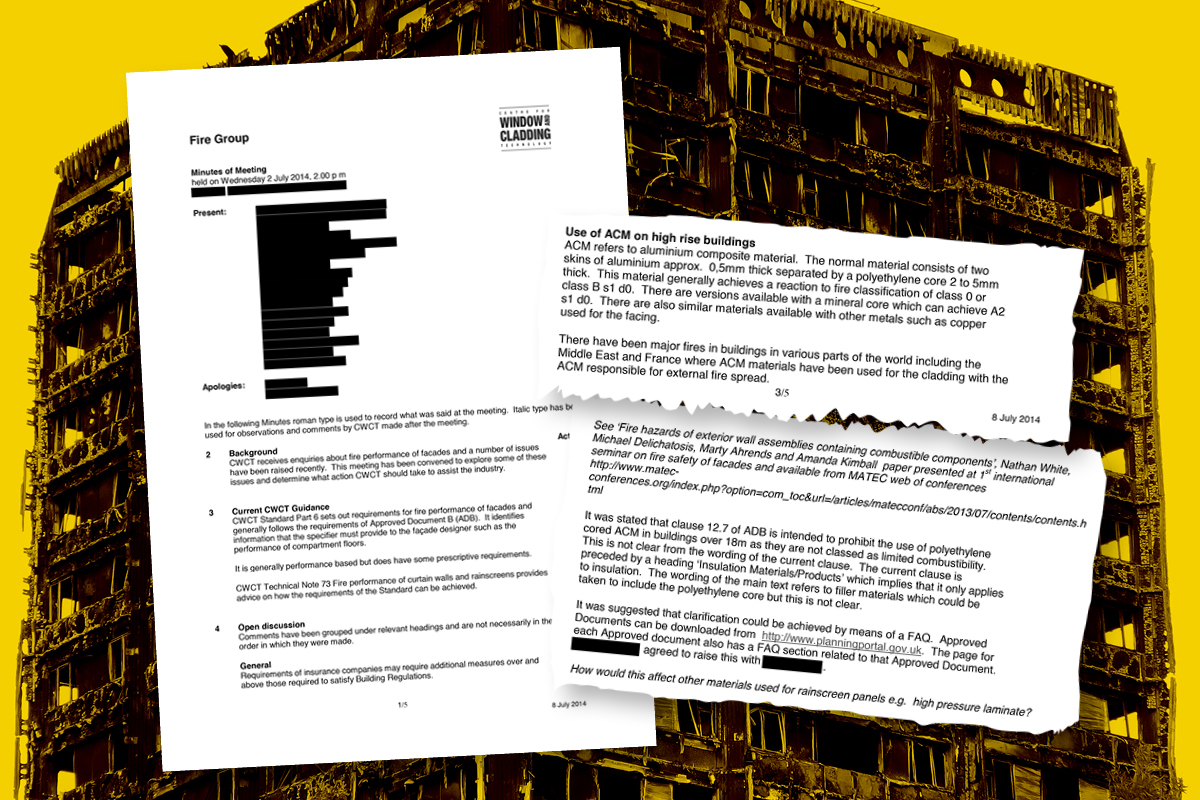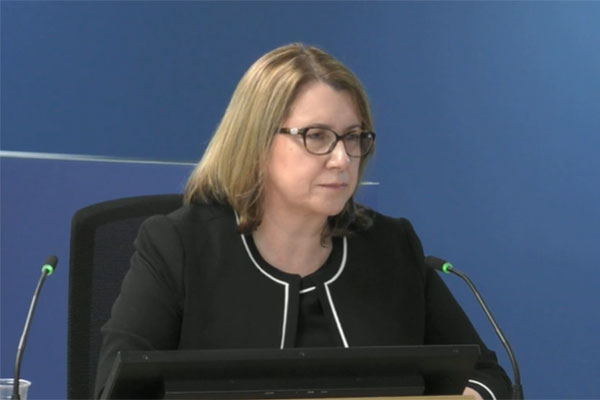Senior government official failed to provide ‘desperately needed’ clarification over Grenfell cladding
A senior government official failed to provide “desperately needed” clarification that Grenfell Tower’s highly combustible cladding should not have been used on high rises, despite multiple warnings in the years leading to the blaze that existing guidance was not clear.
The inquiry into the fire today heard critical evidence about meetings and emails between Brian Martin, the civil servant responsible for official guidance on fire safety, and industry body the Centre for Window and Cladding Technology (CWCT) between 2014 and 2016.
As Inside Housing has previously revealed, Mr Martin attended a meeting arranged by the CWCT in July 2014 where industry figures warned that official guidance appeared to permit the use of combustible aluminium composite material (ACM) cladding on high rises.
The Building Research Establishment (BRE), which also attended the meeting, agreed to draft a frequently asked question (FAQ) which would clarify that this material should not be used.
But despite completing a draft in March 2015 and repeated chasing, nothing had been released by the time of the Grenfell fire in June 2017.
The timing is particularly pertinent as the inquiry has already established that the team which refurbished the tower made the decision to install ACM cladding in summer 2014, with the work not complete until 2016.
The warnings also came at a time when the coalition government was committed to reducing regulation, with then-prime minister David Cameron promising to “kill health and safety culture” in 2012 and ordering civil servants to remove two restrictions for every new one imposed.
The inquiry also heard claims today that as Mr Martin left the July 2014 meeting, he commented “there is going to be a major fire”.
David Metcalfe, director of the CWCT, who gave evidence today, explained that concerns about the use of ACM had first come to his attention in summer 2013, when he was warned by Nick Jenkins, former technical director at cladding firm Euroclad, that the product had been linked to several major fires in the Middle East.
At this stage, Mr Metcalfe believed that the requirement for cladding panels contained in official guidance Approved Document B was ‘Class 0’ – a fire classification which primarily considers the surface of a material, meaning some ACM products could obtain it despite their violently combustible core.
The inquiry saw that CWCT invited Mr Martin to a meeting to discuss various cladding-related fire safety issues, including “the performance of composite materials such as ACM”.
This meeting, also attended by various senior figures from industry and experts, took place in July 2014, with Mr Martin only attending the first half.
He was present for a discussion on the use of cavity barriers, designed to stop the spread of flame through gaps in a cladding system. The meeting was said to have discussed the problem of poor workmanship, with claims that inspections had revealed the barriers falling to the ground or never having been installed.
According to the witness statement of one attendee, Mr Martin left following this conversation and said “something along the lines of ‘there is going to be a major fire’” as he departed. Asked about this, Mr Metcalfe said he did not recall the comment.
Mr Metcalfe said the issue of ACM was raised after Mr Martin left, with Sarah Colwell of the BRE telling the group that “the intention” of Approved Document B was to ban its use.
He says she based this on a passage which required “insulation materials” to be of ‘limited combustibility’ – a fire standard which combustible ACM of the type used on Grenfell Tower could not achieve.
However, Mr Metcalfe said this view was “not consistent” with the guidance itself, which suggested the required standard for cladding panels was the lower Class 0.
“We were surprised to hear what Sarah Colwell had to say, and we would have certainly questioned how [she] reached that conclusion because it didn’t seem logical to us,” he said.
“We were being offered in an interpretation or a view that didn’t appear consistent with what was written [in Approved Document B].”
Mr Metcalfe said that Ms Colwell suggested the use of an FAQ to clarify this point and said she would “discuss the issue with Brian Martin to agree a way forward”.
Mr Metcalfe told the inquiry he expected this clarification to be issued “within weeks”, but further emails show a meeting was scheduled with Ms Colwell in September to discuss the correct wording.
“So we’re getting beyond weeks into months and still no FAQ. Were you concerned by this stage?” asked lead counsel to the inquiry Richard Millett QC. Mr Metcalfe said he was not, but added “it would have been better if it had been quicker”.
At the September meeting, Ms Colwell was said to have agreed to draft the FAQ and send it back to the CWCT for comment.
However, by March 2015, no draft had been provided and Mr Metcalfe emailed Ms Colwell for an update. She responded saying it had been “drafted and revisited” and would “hopefully be closed out soon”.
The inquiry then heard that Mr Metcalfe continued to chase Ms Colwell for an update – sending five emails, plus several phone calls and voicemails through to November 2015. She did not respond.
In January 2016, the issue of ACM panels was again raised by Mr Jenkins who warned at an industry conference that the product was in wide use and risked the UK suffering a repeat of the huge fires seen in the Middle East.
As the inquiry has previously seen, he followed up by emailing Ms Metcalfe, Ms Colwell and Mr Martin warning of his “grave concern” over the use of ACM and called for fresh guidance to clarify that it should not be used.
But Mr Martin responded saying he did not believe the guidance “was all that ambiguous”. He added: “If the designer and building control body choose to do something else then that’s up to them.”
“Did that surprise you when you read it?” asked Mr Millett.
“Yes,” replied Mr Metcalfe. “Our view as we’ve discussed, is that it was ambiguous. Brian Martin… did receive the minutes of [the July 2014 meeting]. And to say that it’s not ambiguous, I don’t think that is correct.”
The CWCT held another meeting, with both Mr Martin and Ms Colwell in attendance, in March 2016.
Minutes record that Mr Martin said Approved Document B was intended to ban the use of combustible cladding due to the phrase “filler material” in the section on insulation.
This was supposed to be a “catch all” term, he said, meaning all materials in the external wall should have met the standard of limited combustibility.
The minutes record that the heading of this passage would change in the next version of Approved Document B to remove any ambiguity. But this change had not been made by the time of the Grenfell Tower fire.
Mr Metcalfe said he “had my doubts” that the word ‘filler’ really was intended in this way. He said the clause was “poorly written” and “misleading”, but said he was still “content” to follow the government’s interpretation going forward.
CWCT then published guidance to its members in April 2017 which said all elements of the cladding system should be ‘limited combustibility’ and ACM.
“Is that the clarification that you had been wanting to make… and which I think you’d known since June 2013 had been desperately needed by industry?” asked Mr Millett.
“Yes,” replied Mr Metcalfe.
However, he said no consideration was given to the potential danger to buildings which had followed the prior interpretation of the guidance.
“Was there a sense in which the historical legacy of this poorly drafted clause was to some extent an elephant in the room?” asked Mr Millett.
“To be honest I don’t think it was, because that simply wasn’t what we were focusing on,” replied Mr Metcalfe.
“No one thought to… ask themselves the question, well… there’s a 10-year legacy of misunderstanding by the UK construction industry, what are the life safety implications of that?” asked Mr Millett.
“I don’t know,” replied Mr Metcalfe.
The inquiry heard last week that two days after the fire in June 2017, Mr Martin contacted a senior industry figure asking her to “state publicly” that Approved Document B did ban the use of ACM, based on his contested interpretation of the relevant clause, in order to rebut a news report that claimed its use was permitted in the UK.
The inquiry continues with evidence from Dr David Crowder of the BRE tomorrow.
Sign up for our weekly Grenfell Inquiry newsletter
Each week we send out a newsletter rounding up the key news from the Grenfell Inquiry, along with the headlines from the week
Already have an account? Click here to manage your newsletters




